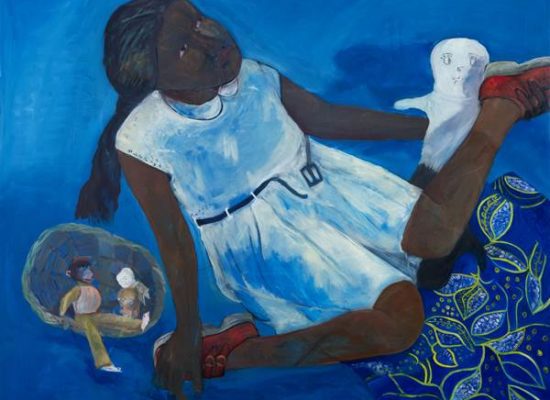The body of work that greets you at June Kelly Gallery on Mercer Street is enigmatic. Enigmatic, because vivid, brightly colored canvases, brimming with young faces, are fraught with melancholic, grave expressions. In many ways, Philemona Williamson’s paintings are an embodiment of adolescent angst, restlessness and hopelessness. Girls are entangled in one another, limbs are indistinct, and solemn expressions appear throughout.
The expressions betray fear and wariness. Williamson’s figures, whether roughhousing or running away, are nevertheless intoxicating. Her dramatic use of black and color make for intense portraits that conjure up memories and suggest an encounter with a younger generation.
Williamson talked to artnet News about the tensions in our childhood and why she prefers when her audience challenges her narrative.
Your works exude an aura of anticipation. You represent characters “caught in the moment.” Why is that?
My work is about the transitions between childhood, adolescence, and adulthood. It’s a period of our lives that we want to hold on to as long as we can. It’s so fragile yet it’s also a magical time. I wanted the paintings to capture that time. But it’s not only about the magical good stuff, it’s also the magical that’s fraught with anxiety and all the rest of adolescent feelings. These emotions add a certain type of energy to a person. Anything seems possible. I wanted people to be in touch with that sentiment.
Can you discuss the tension you’re trying to represent? You pair seemingly playful acts or innocent situations with quite solemn faces, giving your work a darker quality.
I think of my characters as growing into adulthood from adolescence. I don’t think of them as children. The period I’m targeting is between the ages of 14 to 23. They’re young adults, they are still very innocent as children are, and yet, today, our youth is exposed to so many influences that are dark and hard, whether those are the realities of rape or racial tensions. They have to assimilate all of these painful realities as well as the act of play into their world. But how does one do that? How do you manage both of those things and still feel hopeful? I’m looking at my characters as wiser than the real adolescent today might be. That’s why their faces are maybe more solemn. As a young adult, you have to internalize so many things and it’s overwhelming.
What is one takeaway you’d like to leave your audience with?
I’ve never really thought of it in those terms. But I do love it when someone looks at my work for the first time and comes up with a different narrative than the one I’ve had in my head. That’s perfect because the meaning of my paintings is not written in stone. I prefer to think of it as a dialogue. In my piece, “Round About Midnight,” there’s a strand of red paint at the girl’s foot. Someone once looked at that and saw it as menstrual blood. But actually, for me, it was just a piece of barbed wire, a metaphor for something that’s holding and tripping someone. And why red? Because, formally I needed that color there. A lot of times, my colors will take on different meanings.
Can you discuss the placement of common-place objects in your works?
I didn’t want my figures located in any specific time or place so I picked objects that could be in any period. I didn’t want someone to read into specifics, label or categorize my figures. It’s a time frame that could be here, there, anywhere. It’s not fixed. The objects are meant to conjure up memories that could very well be imaginary. And what’s important is that the memories are cross-generational also.
And why the intermingling of limbs in your paintings?
I like the idea that when you’re young, you hug and play and want to be part of your friend, in a sense. You don’t feel the distance and social barriers like we do as adults. Compositionally also, I wanted to create a feeling of movement and distortion.
What inspires you?
In terms of the narrative in my piece, it’s how I am reacting to things that are going on in the world. I profoundly feel that the most vulnerable people are constantly taken advantage of—young girls, for example. Color, of course, also inspires me. The history of my upbringing inspires me. I was brought up in a very interracial, cultural family where barriers were set, but malleable.
Why are some figures faceless? Like those in “Sunset” or “Satin Doll”?
I didn’t want them to be thought of as specific people. I wanted to create a dreamlike, or contemplative, space. I felt that if I were to put detail in the faces, it gets too real and people start wanting to know who that person is. With “Satin Doll”, I really wanted to show the process of how things are painted differently. I wanted to show the history of the paint. I’m an old-fashioned painter. And actually, I feel quite vulnerable showing those works.
Williamson’s show, “Black & Colored,” is on view at June Kelly Gallery, April 10–May 12, 2015.
